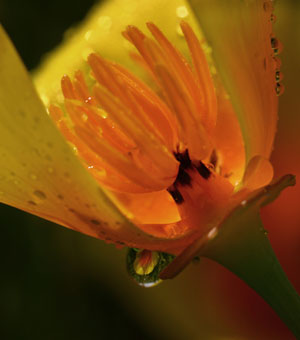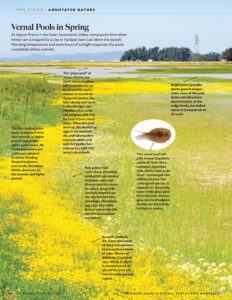Sepal, stigma, stamen, style; pollen, pistil, petal. Say what?! Like all scientists, botanists have a specialized language for talking about the things they study—in this case, flowers.
Next time you’re out hiking, take a few minutes to look closely at a wildflower and you can discover these fascinating, strangely named parts for yourself.
Our state flower, the California poppy, is a good one to start with because its parts are easy to see. Sit down next to a nice patch of orange poppies and pick a big, open flower.
Flower parts come in four concentric rings, or whorls. The parts in the outermost whorl are called sepals. They often look like narrow green leaves, and once the flower has opened, they sit below all the other parts. But if your poppy has bloomed, you won’t be able to see the sepals because they fall off when the flower opens. (On most other flowers, the sepals stay attached. When looking at flowers, it’s good to keep in mind that there isn’t one standard flower form—just infinite variation on a theme.) Unopened poppies wear green dunce caps; those are their sepals, which protect the tender flower parts developing inside.
- Poppy stamen, photo by Stacy Boorn
Inside the ring of sepals is the next whorl—the petals. These often brightly colored banners are just as attractive to insects and birds as they are to us. The animals are after sugary nectar inside the flower, but along the way, they help the plant create the seeds for another generation of flowers.
Enjoy the beauty and silkiness of the poppy’s petals, then tear them off the flower. (Botanists have to be ruthless in the name of science.)
Attached to each now-detached petal are a few short, flat, matchstick-like parts. These are the stamens, the “male” parts of the flower. On the end of the stamen, the anther holds the pollen, thousands of tiny grains containing the plant’s male reproductive cells. Those nectar-seeking critters often carry pollen between flowers, though wind and water do it for some plants.
Gently pull off any stamens still attached to the stem in your hand. Now all that’s left is the innermost, “female” whorl of flower parts, called the pistil. Of course, botanists have given a name to each of the three parts of the pistil. The golden tentacles at the top are called the stigma. Often sticky or rough, stigmas of different flowers come in many shapes and colors and catch the pollen that lands on them. The poppy stigma is attached to a green cylinder, called the ovary, where seeds will eventually form when the pollen cells enter and fuse with the ovules, or female cells, inside. Poppies don’t have a third pistil part, but on many other flowers the ovary has a long, narrow neck, called the style.
In every plant species, the four whorls of flower parts come in a unique combination of numbers, colors, and shapes. Some plants even lack whole whorls. That’s what makes the endless variety and beauty of flowers. Now that you know what to look for, you can amuse yourself for hours with a magnifying glass or a hand lens in a field of colorful wildflowers.
* * *
Get Out!
Now that you know their names, you can practice identifying flower parts and much more at Sunol Regional Wilderness’s annual Wildflower Festival. On Saturday, April 11, 2009, there will be many fun, free, flower-focused activities for families and children, including flower dissection, origami, slide shows, and wildflower hikes [11 a.m.-4 p.m. (925)862-2244; East Bay Parks].
Wildflowers will bloom in profusion on May 2 and 3, 2009, at the Oakland Museum’s annual California Wildflower Show. Each spring the museum, in conjunction with the California Native Plant Society and the Jepson Herbarium, fills two rooms with beautifully arranged and carefully identified wildflowers from around the state [Oakland Museum of California].

.jpg)




